Tag Archive: driver safety
Spring Break Safety – How to Identify an Impaired Driver
March 18, 2009
Many spring breakers drive to and from their vacation destinations. Spring break drivers are often relatively inexperienced due to their youth and may have difficulty navigating hazardous driving situations. One way to manage the risk is to spot impaired drivers early so you can increase your space cushion. This way, if the impaired driver causes a crash, you are much less likely to be part of it.
Although the term “impaired” typically refers to drivers who are under the influence of alcohol, for the purposes of this article, it refers to any driver who is exhibiting difficulty with the driving process. A driver may be “impaired” by drowsiness, confusion, distractions inside or outside their vehicle, aggression, talking on a cellular phone, or a variety of other causes. For those who are sharing the road with an impaired driver, the most important issue is that the other driver is impaired; the specific reason isn’t as significant, because the reactions of other drivers should be the same regardless of the source of the impairment.
You should scan the general behavior of other vehicles when you search the driving scene, noticing any drivers who are:
- Drifting within their lane
- Speeding or driving at erratic speeds (speeding up, then slowing suddenly)
- Weaving in and out of lanes
- Exhibiting odd behavior, such as stopping for a green traffic light
- Displaying aggressive behavior, such as following too closely
Once you recognize that a driver is impaired, you must increase the amount of space between your vehicle and theirs. Motorists are often tempted to pass a driver who may be impaired, but this option is dangerous because it decreases the space between you and the impaired driver, even if only temporarily. The point of identifying impaired drivers is to note their unpredictability. If the impaired driver makes another mistake while you are passing, you could be involved in a crash.
Take the following actions when you recognize an impaired driver:
- Reduce your speed. This will increase your following distance if you are behind the impaired driver. Also, reducing your speed will allow you to more safely take other actions, such as changing lanes.
- Continue scanning the driving scene. Don’t get so distracted by the impaired driver that you cause a crash yourself.
- Increase your following distance from other vehicles. If you tailgate the vehicle in front of you, you will be forced to focus on that vehicle to avoid rear-ending it.
- Once you’ve increased your distance from the impaired driver, check the space cushion all around your vehicle – in front, behind, and on both sides. Make sure you haven’t compromised your space cushion in your effort to move away from the impaired driver. Make any necessary corrections carefully. Remember to signal for all lane changes.
- Resume your scan of the driving scene. Impaired drivers are common in popular vacation spots.
If you think an impaired driver is in imminent danger of causing a crash, ask a passenger to note the license plate number, a description of the vehicle, and the vehicle’s location and direction of travel. Have your passenger contact law enforcement, or pull off the road so you can safely make the call yourself.
Make your spring break a safe, healthy, relaxed vacation using defensive driving techniques from the National Safety Commission.

Spring Break Pedestrian Safety Tips
March 3, 2009
Many students look forward to spring break as a rite of passage. Taking a vacation from academics just as the weather turns warmer is a welcome break; it’s a time to hang out with friends and relax. Students often travel to a beachfront community so they can spend the week lying on the sand, playing beach volleyball, and participating in water sports.
Businesses in beachfront communities typically welcome spring breakers. But the increase in all types of traffic can be frustrating for year-round residents, and spring breakers themselves may drive carelessly or recklessly. This can prove deadly for pedestrians, who must often cross beachfront avenues to access the beach or nearby businesses.
According to the National Highway Traffic Safety Administration (NHTSA), in 2007, 4,654 pedestrians were killed and 70,000 pedestrians were injured in traffic crashes in the United States. On average, a pedestrian is killed in a traffic crash every 113 minutes and injured in a traffic crash every eight minutes. Forty-eight percent of all pedestrian fatalities in 2007 occurred on Friday, Saturday, or Sunday.
Tips for Pedestrians
Pedestrian safety is an important, though often unconsidered, aspect of spring break safety. As a pedestrian, follow these tips to make the most of your spring break:
- Put safety first. You are on spring break to have fun, but disregarding your own safety could result in tragedy.
- Don’t assume that motorists will yield to you when you are at an intersection or even in a crosswalk. Be especially careful at intersections where drivers may be turning onto another street. If you are in their path, they may not see you in time to stop.
- Use a designated crosswalk when possible. Stop and look left, right, and left again before crossing.
- Stand on the curb or off the roadway while you make sure it is safe to cross the street. If your view of the street is blocked, stop when you reach the edge line of the object and look around it before entering the roadway.
- Include motorcyclists and bicyclists in your visual search before you cross the street. A collision with any other vehicle, even one with only two wheels, could result in serious injury or death.
- If there is no sidewalk and you must walk in the street, walk facing traffic and be especially careful.
- At night, try to cross the street only in well-lit areas. Increase your visibility to others by carrying a flashlight.
Tips for Motorists
Of all the highway users, pedestrians are the most vulnerable, so drivers have a special responsibility to watch for and protect pedestrians.
- Let go of assumptions you may have about pedestrians so you can put their safety first. Many pedestrians are not fully aware of traffic laws, including those that pertain to signals. Many do not know the distance needed to stop a moving vehicle. Never assume that pedestrians will move out of the way. Be ready to stop to allow a pedestrian to cross safely.
- Many pedestrians take for granted that drivers will yield the right of way to anyone in the crosswalk. When they cross at an intersection with a Walk signal, pedestrians may not even look for oncoming traffic. Always watch for pedestrians in case they are not watching for you.
- Pedestrians waiting to cross the street often stand in the street instead of on the curb. Groups of pedestrians often separate when they are crossing the road. Some may even dash across the street without warning. When you see pedestrians waiting to cross, cover your brake and remain alert.
- Be especially vigilant about pedestrians at night, even in well-lit areas. It is often difficult to identify pedestrians at night.

Preventing Teen Vehicular Crashes
October 10, 2007
Geico, the automobile insurance giant, is not just known for their cute gecko or grunting cavemen commercial shtick. They also produce some great informational tools about your insurance and safe driving tips. There is an informational sheet Geico produced about the Top Ten Tips for preventing teenage crashes.
Really, the information is nothing new to anyone but it pays to be repetitive right? Teens probably only really absorb a quarter of what they hear and read when it is not a subject matter they really want to hear about like cleaning their room or *gasp* how to drive responsibly. Perhaps some parents should use the tip handout and tell their teens there will be a pop quiz on it later! Maybe then they will actually read it.
Anyway… there are some tips on there that are not really emphasized on other responsible teen driving diatribes. For instance, one of the tips is keeping it slow and steady and gradually build up to speedier driving venues. What this means is do not start driving lessons with your teen on the major highways that mimic the infamous Autobahn. Instead ease their way into those roads by practicing on driving within small towns or country roads. Practicing those speedy highways during down times is also beneficial. As the teen (and you as the parent) feel more confident about venturing on the highways in the height of craziness, then you can do so.
Another tip that doesn’t get as much play in the teen driving world is training to drive in poor conditions. Many parents are more apt to keep their teens from driving in the rain, snow or other weather conditions. This means, of course, that your teen will have no experience whatsoever in them. The best thing you can do (even though you won’t want to) is to take them out driving, at least in low populated or slow areas, during these conditions. If anything, drive around in the inclement weather in large parking lots, practicing turns and such for the experience. There are less things to hit in an empty parking lot!
Driving a safe vehicle is another safe teen driving tip and one that many people take for granted. Usually, the teen car is either the family car or a hand-me-down. On occasion, a new car or a used model may be purchased. Whatever you choose for your teen to tool around in, you must be sure that it is safe to drive. In this safe teen driving tip, you are the one that holds the ultimate power.
